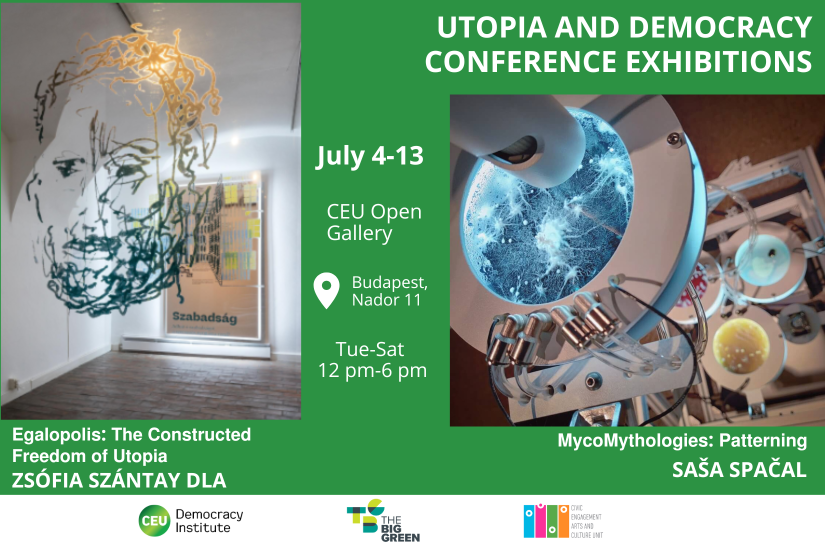
You are cordially invited to the CEU Open Gallery for the opening of two exhibitions on July 3, 2024 at 7:15 pm.
Iva Dimovska, co-organizer of the 𝟮𝟰𝘁𝗵 𝗔𝗻𝗻𝘂𝗮𝗹 𝗖𝗼𝗻𝗳𝗲𝗿𝗲𝗻𝗰𝗲 𝗼𝗳 𝘁𝗵𝗲 𝗨𝘁𝗼𝗽𝗶𝗮𝗻 𝗦𝘁𝘂𝗱𝗶𝗲𝘀 𝗦𝗼𝗰𝗶𝗲𝘁𝘆/𝗘𝘂𝗿𝗼𝗽𝗲 will open the event, followed by Philipp Thapa, a fellow of Sustainable Europe Research Institute Germany, and lead researcher of The Big Green, who will briefly introduce the two exhibitions as part of the 2024 USS/E Conference.
Reception to follow.
The two exhibitions will be displayed at CEU’s Open Gallery from 𝗝𝘂𝗹𝘆 4 - 𝟭𝟯 as a part of the 24th Annual Conference of the Utopian Studies Society/Europe.
The Big Green, a pan-European project that explores sustainable development with the cultural and creative sectors and that is co-funded by the European Union (2023–27), is the co-organizer of this event, together with the Democracy in East Central European utopianism research group
The Open Gallery awaits visitors Tuesday - Saturday from 12 pm to 6 pm. Admission is free.
𝗘𝗴𝗮𝗹𝗼𝗽𝗼𝗹𝗶𝘀: 𝗧𝗵𝗲 𝗖𝗼𝗻𝘀𝘁𝗿𝘂𝗰𝘁𝗲𝗱 𝗙𝗿𝗲𝗲𝗱𝗼𝗺 𝗼𝗳 𝗨𝘁𝗼𝗽𝗶𝗮
An Exhibition by Zsófia Szántay DLA /Nautes Architects/
Step into the realm of Egalopolis, an exhibition born from Zsófia Szántay DLA's /Nautes Architects/ decade-long exploration of the profound connection between utopia and architecture. Aligning with the Utopian Studies Society's 2024 conference theme, this display delves into the concept of utopian built space as an embodiment of individual and communal aspirations for freedom.
Embark on a captivating journey that commences in the fictional realm of the City of the Sun, traversing the dramatic narrative of the Southern Railway Bridge's supporting structure, culminating in the heart of Budapest.
𝗦𝗵𝗼𝗿𝘁 𝗯𝗶𝗼𝗴𝗿𝗮𝗽𝗵𝘆: Zsófia Szántay DLA architect, founder of NAUTES Architects, earned her doctor of liberal arts degree at BUTE. Her theses, ‘Codex Encoder – The message of utopian architecture’ is based on a decade long research on the built space of literary and architectural utopias. In 2023 Zsófia had her first solo exhibition at Budapest Gallery showcasing her theses, art work and fiction book. Besides architecture she studied theoretical linguistics at ELTE and developed a linguistic based method for analysing spatial categorisation, that was introduced at the 2019 International Pragmatics Conference in Hongkong PU. Zsófia is married and the mother of one daughter.
𝗠𝘆𝗰𝗼𝗠𝘆𝘁𝗵𝗼𝗹𝗼𝗴𝗶𝗲𝘀: 𝗣𝗮𝘁𝘁𝗲𝗿𝗻𝗶𝗻𝗴
An Exhibition by Saša Spačal
The MycoMythologies series researches the multilayered question of how mushrooms can help humans think about the possibilities of entangled life in capitalist ruins. As speculative artistic research, MycoMythologies explores not only how fungal underground networks can inform humans, but also how technologies tend to define the teachings that humans receive. The series forms a collection of ontogenetic mythological stories paired with biotechnological installations. Through the MycoMythologies series, the artist expresses deep admiration for the wisdom, work, and legacies of Lion’s Mane (Hericium erinaceus), Octavia E. Butler, Oyster mushroom (Pleurotus ostreatus), radiotrophic fungal communities, and Ursula K. Le Guin.
MycoMythologies: Patterning is a biotechnological installation that captures growing fungal landscapes contaminated by the human microbiome – bacteria, fungi, and archaea derived from the blood, sweat, and tears of the artist. The growing and evolving fungal mycelium of Hericium erinaceus is viewed with a microscope and analysed by computer vision. The images are then rendered on three screens as they are mapped, sonified, and collected into a database named Atlas of Collaborative Contamination. The installation questions whether we can see ourselves as entangled rather than sovereign, reflecting on contamination as a productive exchange between different life forms while we live in ecosystems where human and other-than-human bodies are infrastructures for each other.
Saša Spačal’s exhibition and her participation at the 24th USS/E Conference is supported by The Big Green, a pan-European project that explores sustainable development with the cultural and creative sectors. Co-funded by the European Union, 2023–27.
𝗦𝗵𝗼𝗿𝘁 𝗯𝗶𝗼𝗴𝗿𝗮𝗽𝗵𝘆: Saša Spačal MA [she/her], a postmedia artist, merges living systems research with contemporary art, emphasising the interconnectedness of the environment-culture continuum within planetary metabolisms. Her artistic endeavours include developing caring biotechnological methodologies and interfaces that engage with both organic and mineral soil agents. In parallel, she explores the fragility of posthuman scenarios, intricately weaving mechanical, digital, and organic logics within the realms of contemporary biopolitics and necropolitics.
Her works were presented at venues such as ZKM | Center for Art and Media Karlsruhe [DE], Ars Electronica [AT], Centre de Cultura Contemporània Barcelona – CCCB [ES], Laboratoria Art & Science Foundation / New Tretyakov Gallery [RUS], National Art Museum of China [CHN], Museum of Contemporary Art Metelkova [SI], Onassis Cultural Centre Athens [GR], Transmediale Festival [DE], GHMP Prague City Gallery [CZ], Museum and Galleries of Ljubljana [SI], Museo Extremeño e Iberoamericano de Arte Contemporáneo [ES], Perm Museum of Contemporary Art [RUS], Chronos Art Centre [CHN], Museum of Contemporary Art Zagreb [CRO], Museum of Contemporary Art Vojvodina [SRB]. She received awards and nominations Ars Electronica Starts Prize [2021], Japan Media Art Award [2020], New Technological Art Award [2019], New Aesthetica Prize [2020], Prix Cube [2015] and Prix Ars Electronica [2015].